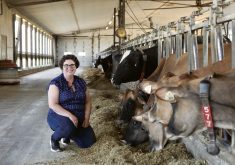Barring major shocks to the agriculture sector, the outlook is for continued strong farmland values and tight farmland availability in Canada for the foreseeable future.
“By and large, we see a very healthy, very robust farmland market out there, and it seems to be continuing,” says Tom Eisenhauer, president and CEO of Toronto-based Bonnefield, Canada’s largest farmland sale-leaseback provider.
Farm Credit Canada reports Canadian farmland values increased at an average annual rate of 8.4 per cent in 2017. Farmland has grown in value each year since 2013, but it slowed from 22.1 per cent growth in 2013 to 10.1 per cent in 2015, FCC says.
Read Also

Riding the tariff rollercoaster
Farmers are accustomed to roller-coaster years. But the current geopolitical windstorm is something else entirely. On his cattle operation near…
Eisenhauer cites steadily increasing farm incomes to explain farmland’s value growth.
“Farmland values are a function of many variables but are most strongly correlated to farm cash income,” agrees realtor Tim Hammond of Hammond Realty.
Statistics Canada last spring reported realized net income decreased in 2017, but only for the first time since 2013 and the second since 2009. And while first-quarter 2018 farm cash receipts decreased, that represented the first year-over-year decline for a first quarter since 2014.
FCC chief agricultural economist J.P. Gervais also attributes high demand, a tight supply of available land and a positive outlook for the ag sector to the strength in Canadian farmland values.
Gervais says it’s easier to get a sense of the industry’s optimism by how much more buyers are willing to bid.
Optimism fuels optimism
Farmers’ perceptions about the state of agriculture and the direction farmland values are taking will affect the amount of land offered for sale this winter, says Saskatchewan realtor Tim Hammond.
“If farmers close to retirement perceive that revenues on their farms have peaked and farmland values are going to trend sideways from here, they may want to get out sooner rather than later,” says Hammond, based at Biggar. “If they believe there is more growth potential, they may choose to wait another year or two.”
Land may continue to appreciate, but at a much slower rate than in the past decade, Hammond predicts. “While there is still some positive momentum, the bulk of the increase has transpired already.”
Phil Spoelstra of Remax Farm Ontario Team also believes the dramatic appreciation has already plateaued.
“It’s been two to three years depending on the area, where things have settled down to increases that are more aligned with inflation,” he says, adding he hopes it stays that way. “That’s manageable, it’s stable and most buyers don’t have too much problem with where land values are right now. I would expect them to stay pretty stable here.”
Gervais wonders if perhaps buyers have reached a point where, after strong increases in land values, it makes sense for demand to slow down a bit.
Says Gervais, “Year-over-year, we’re not seeing as many transactions.”
A U.S. golden goose?
With slumping U.S. land prices, we ask it it’s time to look south
U.S. farm income may be falling while debt rises, but don’t expect that to slash farmland prices and create juicy buying opportunities for Canadian farmers.
The U.S. Department of Agriculture recently forecast net farm income to decrease 13 per cent or $9.8 billion from 2017 to $65.7 billion in 2018, and farm debt to increase by 3.5 per cent or $13.8 billion to $406.9 billion.
Those forecasts, however, don’t include recently announced government assistance packages to farmers in response to trade disputes.
Nevertheless, Bonnefield’s president and CEO Tom Eisenhauer argues that the U.S. farm situation isn’t as disastrous as the press is making out.
Media reports have focused on the major discrepancies between 2018 and 2013, which Eisenhauer argues is an unfair comparison.
The U.S. ag sector enjoyed record high income in 2013 as net farm income reached $129 billion.
“Everybody keeps measuring farm profits from 2013, which were an absolute aberration in the history of farming worldwide,” says Eisenhauer. “Yes, they’ve declined, but if you were to draw that arrow from back in 2008, 2009, 2010, the drop hasn’t been nearly as precipitous.”
Eisenhauer adds that while farm debt increased, there’s been no significant increase in defaults, while interest rates remain at historically low levels.
“It’s definitely much more difficult there than it has been for Canadian farmers, but it’s not the disaster people have made it out to be,” Eisenhauer says. He also points out that despite big declines in farm incomes since 2013, U.S. farmland values haven’t been dragged down.
In fact, in 2013 USDA put average farm real estate values at $2,900 per acre, or $240 below its current estimates.
Farmland values
“It’s not that prices have declined significantly in the States, it’s just they haven’t gone up much in the last couple years,” says Eisenhauer.
In August USDA reported U.S. farm real estate values averaged $3,140 per acre for 2018, up 1.9 per cent, or $60 per acre, from the previous year.
Regionally, average farm real estate values ranged from an 8.3 per cent increase in the Southern Plains to a 1.4 per cent decrease in the Northern Plains, USDA reported.
But since farmland values are tied to farm income, further weakness in profitability could filter down to the price of real estate.
Phil Spoelstra of Remax Farm Ontario says U.S. farmers are bound to see greater commodity price volatility, whereas producers in Ontario will be much better insulated by supply management and a low Canadian dollar.
Opportunities
Eisenhauer’s firm works with farmers in southwestern Ontario and in Western Canada who farm on both sides of the border, and they tell him there might be some buying opportunities there.
“(Farmland values) kind of stagnated in several parts of the States. Maybe that creates an opportunity for Canadians.”
Spoelstra is aware of Ontario born-and-raised farmers who have taken the plunge.
“We know dairy farmers that have looked south of the border because they wanted to milk a lot more cows. But it’s a small handful. And it’s generally coming from the younger demographic.”
But the uncertainty about the possibility of a second Trump term is keeping speculators on the sidelines, Spoelstra adds.
“I think a lot of people are waiting to see if he lasts more than four years before they would do anything. Nobody wants to stick their hand so far in where they can’t get it back,” Spoelstra says.
Risky proposition
Farm Credit Canada’s chief agricultural economist J.P. Gervais warns it’s no slam dunk, especially considering the stark differences between farm policies in the two countries.
He thinks it’s too early. Maybe there will be a buying opportunity but there are numerous long-term issues still to be resolved, especially what U.S. trade will ultimately look like. It’s still a rocky road to navigate, Gervais says.
Eisenhauer agrees it’d be a tough venture for a farmer without thorough knowledge about the many potential pitfalls to dive into U.S. farmland ownership.
The value of the Canadian dollar relative to the U.S. greenback is one major stumbling block, as its weakness, while helping domestic profitability, would actually hurt buying power down south.
There are also differences in taxes and laws to consider.
“You’ve got to be a farmer who really knows what they’re doing and be comfortable in operating in two different currencies and two different sides of the border before you decide that in a major way,” says Eisenhauer.
Community roots
Most producers would also prefer farming closer to home.
“We don’t hear about many farmers considering a move south of the border,” says Spoelstra. “Definitely you hear more frequently moves within Canada, to the east coast if they’re looking for value, but they want to stay within Canada.”
Hammond Realty president and CEO Tim Hammond concurs, saying farmers are location specific and keener on acquiring land that’s near them. “If some of that farmland presents itself, one must purchase at market price or forgo the opportunity for another quarter century.”
















